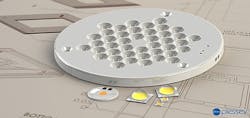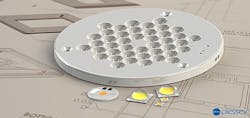SSL modules with a collimating reflector placed over each LED can enable luminaires such as downlights to be far thinner than the legacy form factor and thinner than most LED-based versions.
On the LED Professional Symposium (LPS) exhibit floor, Plessey finally revealed the details of its Stellar LED module technology that had first been discussed back at Light+Building (L+B) early this year. The module, composed of LEDs on a printed circuit board (PCB) and a relatively thin optical component with reflectors for each LED, will enable solid-state lighting (SSL) product developers to realize downlights and track heads with far thinner form factors relative to those on the market today.
Interested in articles & announcements on LED modules?
We found the Plessey L+B announcement earlier this year to be very confusing because it mixed discussion of the Stellar technology and what it turns out is a separate concept — chip-scale optics (CSO). At the LPS, Paul Drosihn, head of LED modular products at Plessey, clarified the situation. Plessey had discussed the CSO concept a year ago in which the opaque silicon growth substrate would be manipulated in the back end of the LED manufacturing process to form reflector optics on each die. The fact that Plessey is focused on silicon-based LEDs with its Magic (Manufactured on GaN-on-Si I/C) technology platform would enable the formation of such optics, whereas the process would not be so straightforward with a transparent sapphire substrate such as the ones used by most LED manufacturers.
Drosihn, however, said the CSO technology development will not be commercialized for another year or so. Stellar, meanwhile, provides a stepping stone toward the same goal — optical control of individual LED beams that in turn enables all-new thin form factors in luminaires for downlights, tracklights, and similar uses.
Such luminaires have typically been relatively deep whether recessed into ceilings or exposed as heads on a track. The depth has been necessary to control the light and deliver a narrow beam. Legacy sources such as directional lamps have mainly integrated the reflectors in the bulb, although the bulbs were inherently deep. The move to LED sources has resulted in much the same luminaire form factor with the LEDs mounted at the base of the luminaires requiring a large reflector and a heat sink may add further to the minimum depth.
The Stellar approach which you can see in a nearby photo uses a custom plate with much smaller optical collimators fabricated into the plate for each LED. Because the reflector elements are placed directly on top of each individual LED, the entire module can be only 5.6 mm thick, without the heat sink, while delivering similar beam control to a 100-mm-deep reflector in most existing LED-based directional luminaires.
Drosihn said the Stellar approach offers even more advantages over typical LED-based directional luminaires. He said most such SSL products today use a single chip-on-board (COB) LED at the base of the reflector. But he said even the best COB LEDs don’t deliver consistent color over angle. Moreover, he said over the course of use in an installation, COBs get hotter in the center than along the outer diameter, and the color inconsistency worsens over time. In the LPS demonstration, Plessey was using some prototypes that seemed to deliver consistent color, although that's a tough judgment call to make in a convention hall.
The Stellar-based module that Plessey demonstrated was the Orion PLWS3000 series. It measures 82 mm in diameter, and can deliver more than 3000 lm. As another of the nearby photos illustrates, Plessey had developed a relatively shallow heat sink that attached to the back side of the module as a demonstration vehicle. Ultimately, Plessey would expect that the luminaire developer will design the appropriate heat sink and make the decision as to whether to integrate a driver in a product or locate it remotely.
Drosihn also stated that the Orion module produced no glare, although a floor-mounted unit shining upwards onto signage at an angle did seem to produce some glare. Moreover, were an Orion-based luminaire mounted on a ceiling, you would see the individual LED sources were you to look up directly at the product. But Drosihn said lighting designers care primarily about the uniformity of the light projected onto a surface and you could see no pixellation onto the surfaces at the demo.
"The Orion focuses on replacing design limitations with opportunities thus providing lighting designers with a new level of design freedom," said Drosihn. "The size/performance envelope we have achieved allows industrial high bay and architectural luminaires used in high-end offices, homes, and retail outlets to be created in a new way. With a particular emphasis on improving the thermal characteristics, the heat sink can also be reduced in size allowing the end fixture to be less obtrusive. The Orion will revolutionize the expectations in the lighting market."
At LPS, Plessey was also showing its latest work in the horticultural lighting space after partnering with horticultural specialist PhytoLux earlier this year. The company demonstrated a typical high-bay luminaire with red, blue, and phosphor-converted white LEDs that would be used in supplemental greenhouse-lighting applications. Plessey can supply the blue and white LEDs used in such a product, although the red LEDs would have to be sourced elsewhere. If you have interest in the horticulture space, don’t miss our upcoming Horticultural Lighting Conference scheduled for Oct. 12 in Chicago.







